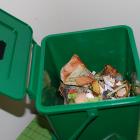You are here
» » This year’s new year's resolution: to...
This year’s new year's resolution: to start composting!
Not only does composting reduce the amount of trash headed for the landfill, but the increase in carbon from organic inputs is one of the best ways to improve soil quality and soil carbon sequestration, or the process of recycling carbon between the atmosphere and reservoirs. Organic material that could easily be composted becomes a major source of methane emissions once it enters a landfill and decomposes under anaerobic conditions. Methane, as we know, is a very potent greenhouse gas with 21 times the global warming potential of carbon dioxide. Nevertheless, the EPA estimates that food scraps and yard waste currently make up 20-30% of landfill waste, generating 20% of the total methane emissions in the US.
So, how does one begin his or her own compost? The EPA identifies five primary variables that need to be controlled:
1) Nutrient Balance – This can be controlled through the balance between what is known as “green” and “brown” organic materials. “Green” organic materials are high in nitrogen and include grass clippings and garden waste; food and vegetable scraps; coffee grounds; and manures. “Brown” organic materials are high in carbon and include items like dried leaves and twigs; pine needles and bark; shredded newspaper and cardboard; and fruit waste.
Read more

